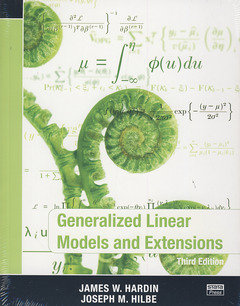Description
Generalized linear models and extensions (3rd Ed.)
Authors: HARDIN James W., HILBE Joseph M.
Language: English
Subject for Generalized linear models and extensions:
Approximative price 75.10 €
In Print (Delivery period: 15 days).
Add to cart
Publication date: 07-2012
462 p. · 15.2x22.9 cm · Paperback
462 p. · 15.2x22.9 cm · Paperback
Description
/li>
Generalized linear models (GLMs) extend linear regression to models with a non-Gaussian, or even discrete, response. GLM theory is predicated on the exponential family of distributionsa class so rich that it includes the commonly used logit, probit, and Poisson models. Although one can fit these models in Stata by using specialized commands (for example, logit for logit models), fitting them as GLMs with Stata's glm command offers some advantages. For example, model diagnostics may be calculated and interpreted similarly regardless of the assumed distribution. This text thoroughly covers GLMs, both theoretically and computationally, with an emphasis on Stata. The theory consists of showing how the various GLMs are special cases of the exponential family, showing general properties of this family of distributions, and showing the derivation of maximum likelihood (ML) estimators and standard errors. Hardin and Hilbe show how iteratively reweighted least squares, another method of parameter estimation, is a consequence of ML estimation using Fisher scoring. The authors also discuss different methods of estimating standard errors, including robust methods, robust methods with clustering, NeweyWest, outer product of the gradient, bootstrap, and jackknife. The thorough coverage of model diagnostics includes measures of influence such as Cook's distance, several forms of residuals, the Akaike and Bayesian information criteria, and various R2-type measures of explained variability. After presenting general theory, Hardin and Hilbe then break down each distribution. Each distribution has its own chapter that explains the computational details of applying the general theory to that particular distribution. Pseudocode plays a valuable role here, because it lets the authors describe computational algorithms relatively simply. Devoting an entire chapter to each distribution (or family, in GLM terms) also allows for including real-data examples showing how Stata fits such models, as well as presenting certain diagnostics and analytical strategies that are unique to that family. The chapters on binary data and on count (Poisson) data are excellent in this regard. Hardin and Hilbe give ample attention to the problems of overdispersion and zero inflation in count-data models. The final part of the text concerns extensions of GLMs, which come in three forms. First, the authors cover multinomial responses, both ordered and unordered. Although multinomial responses are not strictly a part of GLM, the theory is similar in that one can think of a multinomial response as an extension of a binary response. The examples presented in these chapters often use the authors' own Stata programs, augmenting official Stata's capabilities. Second, GLMs may be extended to clustered data through generalized estimating equations (GEEs), and one chapter covers GEE theory and examples. Finally, GLMs may be extended by programming one's own family and link functions for use with Stata's official glm command, and the authors detail this process. In addition to other enhancements,for example, a new section on marginal effects, the third edition contains several new extended GLMs, giving Stata users new ways to capture the complexity of count data. New count models include a three-parameter negative binomial known as NB-P, Poisson inverse Gaussian (PIG), zero-inflated generalized Poisson (ZIGP), a rewritten GP, two and three-component finite mixture models, and a generalized censored Poisson and negative binomial. This edition has a new chapter on simulation and data synthesis, but also shows how to construct a wide variety of synthetic and Monte Carlo models throughout the book.
© 2024 LAVOISIER S.A.S.




